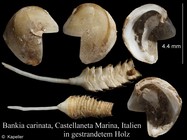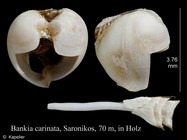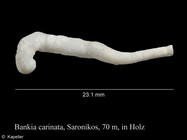
| Intro | | Search taxa | | Browse taxa | | Distributions | | Terminology | | References | | Statistics | | Online sources | | Tutorial | | Log in |
WoRMS taxon detailsBankia carinata (J. E. Gray, 1827)
141598 (urn:lsid:marinespecies.org:taxname:141598)
accepted
Species
Bankia (Bankiella) edmondsoni Nair, 1954 · unaccepted
Bankia (Bankiella) indica Nair, 1954 · unaccepted
Bankia (Bankiopsis) caribbea Clench & R. D. Turner, 1946 · unaccepted (basionym of synonym)
Bankia caribbea Clench & R. D. Turner, 1946 · unaccepted (synonym)
Bankia consularis Moll, 1935 · unaccepted (probable synonym)
Bankia edmondsoni Nair, 1954 · unaccepted (synonym)
Bankia indica Nair, 1954 · unaccepted > junior subjective synonym
Bankia kuronunii Roch, 1929 · unaccepted (synonym)
Bankia nakazawai Kuronuma, 1931 · unaccepted (synonym)
Bankia oryzaformis Sivickis, 1928 · unaccepted (synonym)
Bankia segaruensis Roch, 1929 · unaccepted (synonym)
Bankia stutchburyi (Blainville, 1828) · unaccepted
Bankia syriaca Roch, 1936 · unaccepted (synonym)
Bankiopsis carribaea (Clench & R. D. Turner, 1946) · unaccepted (synonym)
Nausitora kamiyai Roch, 1929 · unaccepted (synonym)
Nausitora orientalis (Roch, 1929) · unaccepted (synonym)
Nausitoria orientalis Roch, 1929 · unaccepted (probable synonym)
Teredo bipalmata Delle Chiaje, 1829 · unaccepted (synonym)
Teredo carinata J. E. Gray, 1827 · unaccepted (original combination)
Teredo minima Blainville, 1828 · unaccepted (synonym)
Teredo stutchburyi Blainville, 1828 · unaccepted (synonym)
Xylotrya philippii Gray, 1851 · unaccepted
marine,
recent only
(of Teredo carinata J. E. Gray, 1827) Gray, J. E. (1827). Monograph of the genus <i>Teredo</i> of Linne, with descriptive characters of the species in the British Museum. <em>The Philosophical Magazine.</em> (2) 2: 409-411., available online at https://www.biodiversitylibrary.org/page/15530937
page(s): 411 [details]
MolluscaBase eds. (2025). MolluscaBase. Bankia carinata (J. E. Gray, 1827). Accessed through: World Register of Marine Species at: https://www.marinespecies.org/aphia.php?p=taxdetails&id=141598 on 2025-07-14
Date action by
Nomenclatureoriginal description
(of Teredo bipalmata Delle Chiaje, 1829) delle Chiaje S (1829) Memorie sulla storia e notomia degli animali senza vertebre del Regno di Neapel. Napoli 4: 1-72., available online at https://doi.org/10.5962/bhl.title.10021 page(s): 28, 32, 115 [details] original description (of Teredo carinata J. E. Gray, 1827) Gray, J. E. (1827). Monograph of the genus <i>Teredo</i> of Linne, with descriptive characters of the species in the British Museum. <em>The Philosophical Magazine.</em> (2) 2: 409-411., available online at https://www.biodiversitylibrary.org/page/15530937 page(s): 411 [details] original description (of Bankia kuronunii Roch, 1929) Roch F. & Moll F. (1929). Die Terediniden der Zoologischen Museen zu Berlin und Hamburg. <em>Mitteilungen aus dem Zoologischen Staatsinstitut und Zoologischen Museum in Hamburg.</em> 44: 1-22, pl. 1-2. [details] original description (of Nausitora kamiyai Roch, 1929) Roch F. & Moll F. (1929). Die Terediniden der Zoologischen Museen zu Berlin und Hamburg. <em>Mitteilungen aus dem Zoologischen Staatsinstitut und Zoologischen Museum in Hamburg.</em> 44: 1-22, pl. 1-2. [details] original description (of Bankia oryzaformis Sivickis, 1928) Sivickis, P.B. (1928). New Philippine shipworms. <em>Philippine Journal of Science.</em> 37: 285-298. [details] Available for editors original description (of Xylotrya philippii Gray, 1851) Gray, J. E. (1851). An attempt to arrange the species of the family Pholadidae into natural groups. <em>Annals and Magazine of Natural History.</em> (2) 8: 380-386., available online at http://biodiversitylibrary.org/page/2320196 page(s): 386; note: based on Teredo palmulata sensu Philippi, 1844 [details] original description (of Bankia (Bankiella) edmondsoni Nair, 1954) Nair, N. (1954). Shipworms from India. 1. Report on ten species of shipworms from the Madras coast. <em>Records of the Indian Museum.</em> 52: 287-414. page(s): 396 [details] original description (of Bankia (Bankiella) indica Nair, 1954) Nair, N. (1954). Shipworms from India. 1. Report on ten species of shipworms from the Madras coast. <em>Records of the Indian Museum.</em> 52: 287-414. page(s): 393 [details] basis of record Turner, R. D. (1966). <i>A survey and illustrated catalogue of Teredinidae (Mollusca: Bivalvia)</i>. Museum of Comparative Zoology, Cambridge (Massachusetts). ix + 265 pp. , available online at http://www.biodiversitylibrary.org/item/134382 page(s): 93 [details] Identification resourceidentification resource
Cosel, R. von; Gofas, S. (2019). <i>Marine bivalves of tropical West Africa: from Rio de Oro to southern Angola</i>. Publications Scientifiques du Muséum, Paris, IRD Éditions, Marseille (Faune et Flore tropicales, volume 48): 1-1104. page(s): 1002 [details] Othercontext source (Deepsea)
Intergovernmental Oceanographic Commission (IOC) of UNESCO. The Ocean Biogeographic Information System (OBIS), available online at http://www.iobis.org/ [details]
context source (HKRMS) Morton, B. & Morton, J. (1983). <i>The sea shore ecology of Hong Kong</i>. Hong Kong: Hong Kong University Press. 350 pp. [details] additional source Kilburn, R.N. & Rippey, E. (1982) Sea Shells of Southern Africa. Macmillan South Africa, Johannesburg, xi + 249 pp. page(s): 205 [details] additional source Turgeon, D. D., W. G. Lyons, P. Mikkelsen, G. Rosenberg, and F. Moretzsohn. 2009. Bivalvia (Mollusca) of the Gulf of Mexico, Pp. 711–744 in Felder, D.L. and D.K. Camp (eds.), Gulf of Mexico–Origins, Waters, and Biota. Biodiversity. Texas A&M Press, Colleg [details] Available for editors additional source Liu, J.Y. [Ruiyu] (ed.). (2008). Checklist of marine biota of China seas. <em>China Science Press.</em> 1267 pp. (look up in IMIS) [details] Available for editors additional source Coan, E. V.; Valentich-Scott, P. (2012). Bivalve seashells of tropical West America. Marine bivalve mollusks from Baja California to northern Peru. 2 vols, 1258 pp. [details] additional source Velásquez M., Valentich-Scott P. & Capelo J.C. (2017). Marine boring bivalve mollusks from Isla Margarita, Venezuela. <em>The Festivus.</em> 49(3): 247-269. [details] additional source Gofas, S.; Le Renard, J.; Bouchet, P. (2001). Mollusca. in: Costello, M.J. et al. (eds), European Register of Marine Species: a check-list of the marine species in Europe and a bibliography of guides to their identification. <em>Patrimoines Naturels.</em> 50: 180-213., available online at http://www.vliz.be/imisdocs/publications/ocrd/254404.pdf [details] additional source Branch, G. M. (2002). Two Oceans. 5th impression. <em>David Philip, Cate Town & Johannesburg.</em> , available online at http://books.google.es/books?id=W_2QB8ftLgcC [details]  Present Present  Present in aphia/obis/gbif/idigbio Present in aphia/obis/gbif/idigbio  Inaccurate Inaccurate  Introduced: alien Introduced: alien  Containing type locality Containing type locality
From regional or thematic species database
Introduced species vector dispersal Galapagos part of the South Pacific Ocean (Marine Region) Ships: general (burrows) [details]Introduced species vector dispersal United States part of the North Pacific Ocean (Marine Region) Debris: transport of species on human generated debris (board) [details]
To Barcode of Life (2 barcodes)
To Biodiversity Heritage Library (1 publication) (from synonym Bankia edmondsoni Nair, 1954) To Biodiversity Heritage Library (1 publication) (from synonym Bankia segaruensis Roch, 1929) To Biodiversity Heritage Library (1 publication) (from synonym Bankia kuronunii Roch, 1929) To Biodiversity Heritage Library (10 publications) To Biodiversity Heritage Library (2 publications) (from synonym Bankia stutchburyi (Blainville, 1828)) To Biodiversity Heritage Library (6 publications) (from synonym Bankia indica Nair, 1954) To Biodiversity Heritage Library (8 publications) (from synonym Bankia caribbea Clench & R. D. Turner, 1946) To European Nucleotide Archive, ENA (Bankia carinata) To GenBank (11 nucleotides; 3 proteins) To GenBank (11 nucleotides; 3 proteins) (from synonym Teredo carinata J. E. Gray, 1827) To Malacopics (Bankia carinata (J. E. Gray, 1827) Malta, ex coll. J. Trausel) To PESI (from synonym Teredo carinata J. E. Gray, 1827) To PESI To PESI (from synonym Bankia indica Nair, 1954) To PESI (from synonym Nausitora kamiyai Roch, 1929) To PESI (from synonym Bankiopsis carribaea (Clench & R. D. Turner, 1946)) To PESI (from synonym Nausitora orientalis (Roch, 1929)) To PESI (from synonym Teredo minima Blainville, 1828) To ITIS |




